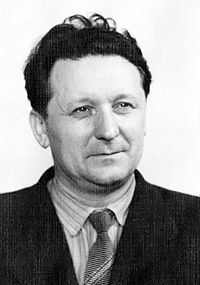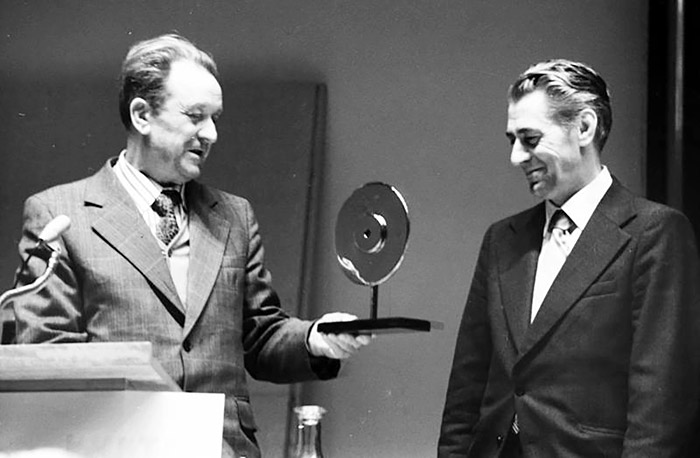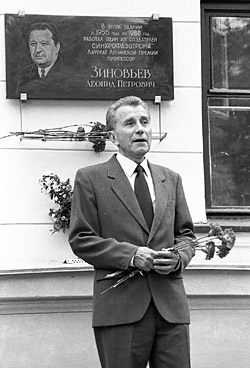
Electronic english version since 2022 |
The newspaper was founded in November 1957
| |
|
Number 14 (4611)
|
Leonid Petrovich Zinoviev. Scientific work and legacy
(28 April, 1912 - 30 May, 1998)
In April of the current year, two remarkable anniversaries were celebrated at JINR at once: 65 years since the launch of the Synchrophasotron and 110 years since the birth of Leonid Petrovich Zinoviev, one of the developers of the Synchrophasotron, a colleague of the outstanding physicists A.I.Leipunsky and V.I.Veksler.
In 1934 the native of Volokolamsk Leonid Zinoviev graduated from the Evening workers' Faculty and entered the Moscow Power Engineering Institute (MPEI), from which he graduated in 1940 and was assigned to the Lenin All-Union Electro-technical Institute. On 17 June 1941, Zinoviev was mobilised to a military unit in a suburban area of Leningrad.
Zinoviev said, "On Friday of 20 June we went to the maneuvers and on 22 June war broke out! I will never forget these harsh days..."
 Throughout the Great Patriotic War, Zinoviev was the commander of an electrical platoon in an aviation unit, he was awarded the Order of the Patriotic War of the 2nd degree and medals that reflected the stages of his military path: "For the Defense of Leningrad", "For the Liberation of Warsaw", "For the Capture of Berlin", "For the Victory over Germany". And after 9 May, Zinoviev was appointed as a Soviet representative at the Saxoniswerke machine-building plant in Dresden by the authorities of Marshal G.K.Zhukov. Only in May 1946, Zinoviev was demobilised, which allowed him to return to his homeland and to science.
Throughout the Great Patriotic War, Zinoviev was the commander of an electrical platoon in an aviation unit, he was awarded the Order of the Patriotic War of the 2nd degree and medals that reflected the stages of his military path: "For the Defense of Leningrad", "For the Liberation of Warsaw", "For the Capture of Berlin", "For the Victory over Germany". And after 9 May, Zinoviev was appointed as a Soviet representative at the Saxoniswerke machine-building plant in Dresden by the authorities of Marshal G.K.Zhukov. Only in May 1946, Zinoviev was demobilised, which allowed him to return to his homeland and to science.
In 1947-1949, he worked at the Laboratory "V" in the village of Obninskoye (now the city of Obninsk) on the project of the first Synchrophasotron in USSR. For this purpose, by order of A.I.Leipunsky, Zinoviev built the current model of the Synchrophasotron for an energy of 180 MeV. It was positioned on the territory of the Lebedev Physical Institute of the Russian Academy of Sciences (LPI RAS) in Moscow in a special building with a height of a two-story house. On 2 May 1949, Corresponding Member of the Academy of Sciences of the Soviet Union the author of the autophasing principle V.I.Veksler was appointed Head of this project. Leipunsky was offered to become Veksler's deputy, but he refused. At the beginning of 1951, Veksler entrusted all the work on the model of Synchrophasotron, including the installation of the facility, adjustment and its complex launch to Zinoviev, who was the only accelerator-experimentator in his team. In order to put the model into operation, many unforeseen technical difficulties had to be overcome. And when they had a success in 1953, Veksler said:
- Well! The Ivankovsky synchrophasotron will run!

Department of New Acceleration Methods, 1980. Celebration of the 50th anniversary of the Head of the Department of New Acceleration Methods Professor V.P.Sarantsev
We emphasize that it referred the same 10 GeV Synchrophasotron, which was embedded in 1951 at the place it is currently positioned. The city of Dubna did not yet exist, the classified settlement of physicists appeared in the documents as Zhilposelok and the nearest unclassified settlement was the village of Novo-Ivankovo. In 1953, on the basis of the Synchrophasotron which was being constructed, the Electrophysical Laboratory of the USSR Academy of Sciences (EFLAN) was developed. V.I.Veksler was appointed the Director of this Laboratory.
 |
| Opening of the memorial plaque for L.P.Zinoviev. I.B.Issinsky is speaking |
"There are 8.3 billion electronvolts!", Central newspapers reported.
From 1957 to 1988, Zinoviev was the Head of the Synchrophasotron Department of the Laboratory of High Energy Physics (LHEP) of JINR. After the Synchrophasotron lost its world leadership in proton energy in the late 1960s, under the leadership and with the direct participation of L.P.Zinoviev, it became the world's first accelerator of relativistic nuclei and polarized deuterons. It became a practical basis for the development of a new research area - relativistic nuclear physics and served as a launching platform for making fateful decisions on the development of Nuclotron (during the lifetime of L.P.Zinoviev) firstly and then the NICA accelerator complex.
Leonid Petrovich died on 30 May, 1998. He was buried in Dubna, the city that became his home.
Kirill Kozubsky, JINR Museum